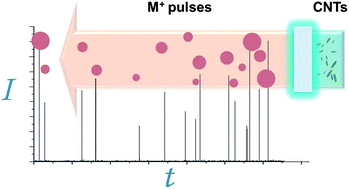Detecting carbon nanotubes by trying to detect the carbon content is tricky in complex environments, as environmental concentrations require sensitive techniques. A team including researchers at the Colorado School of Mines, Johns Hopkins University and the University of Michigan, USA, use the traces of catalytic metals present in carbon nanotubes as an alternative in this Environmental Science: Processes & Impacts HOT article.
 The team use single particle-inductively coupled plasma-mass spectrometry. Carbon is not detectable with normal ICP-MS techniques, but metal particles are and they are usually present in trace amounts after carbon nanotubes’ manufacture. The challenge the group faced was to separate the metal signal from the background.
The team use single particle-inductively coupled plasma-mass spectrometry. Carbon is not detectable with normal ICP-MS techniques, but metal particles are and they are usually present in trace amounts after carbon nanotubes’ manufacture. The challenge the group faced was to separate the metal signal from the background.
The developed technique can detect carbon nanotubes at the nanogram per litre level and can also detect changes in nanotube concentrations when they have been released into the environment from a nanomaterial. Further work will focus on improving the quantification ability of the technique.
Read the detail of how they managed to overcome the difficulty of background and how they intend to improve the quantification in the full article, which is free to access for the next 4 weeks*, by clicking on the link:
Detection of single walled carbon nanotubes by monitoring embedded metals
Robert B. Reed, David G. Goodwin, Kristofer L. Marsh, Sonja S. Capracotta, Christopher P. Higgins, D. Howard Fairbrother and James F. Ranville
DOI: 10.1039/C2EM30717K
*Free access to individuals is provided through an RSC Publishing personal account. Registration is quick, free and simple










